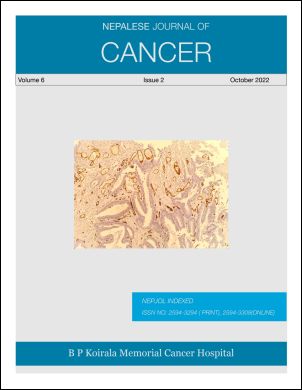Bronchoscopy findings in 1074 lung cancer patients in a tertiary care center in Nepal
DOI:
https://doi.org/10.3126/njc.v6i2.48767Keywords:
Fiberoptic bronchoscopy, Lung cancer, Endobronchial biopsyAbstract
Background: Fiberoptic bronchoscopy is the most important diagnostic tool for lung cancer. Early tissue diagnosis and proper staging remains the key to the management of the lung cancer patient. Endobronchial forceps biopsy has high diagnostic yield from the visible lesions. The aim of the study was to evaluate diagnostic yield of endobronchial biopsy.
Methods: A retrospective cross-sectional study was conducted at B.P. Koirala Memorial Cancer Hospital, Bharatpur, Nepal. Bronchoscopy reports of 1074 patients from January 2000 to December 2009 were included. Endobronchial biopsy was the main procedure performed.
Results: A total of 1074 patients underwent bronchoscopy for suspected lung cancer. Majority of the patients (N=340) had lesion in lobar bronchus. Squamous cell carcinoma was the most common histological diagnosis. The diagnostic yield of endobronchial biopsy was 75%. The diagnostic yield for central tumor was 82.3% which was statistically significant (p<0.001) compared to peripheral tumor and extrinsic compression.
Conclusion: Endobronchial biopsy provides good diagnostic yield especially in central tumors. Fiberoptic bronchoscopy is a safe procedure.
Downloads
Downloads
Published
How to Cite
Issue
Section
License
Copyright (c) 2022 Nepalese Journal of Cancer

This work is licensed under a Creative Commons Attribution 4.0 International License.
This license lets others distribute, remix, tweak, and build upon your work, even commercially, as long as NJC and the authors are acknowledged.
Submission of the manuscript means that the authors agree to assign exclusive copyright to NJC. The aim of NJC is to increase the visibility and ease of use of open access scientific and scholarly articles thereby promoting their increased usage and impact.




